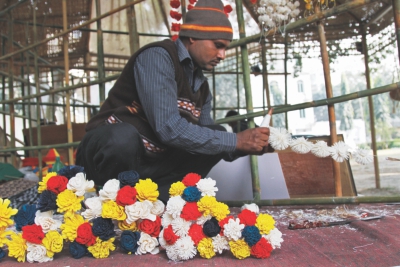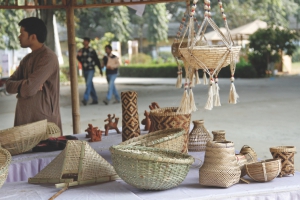| Home - Back Issues - The Team - Contact Us |
 |
| Volume 12 |Issue 03| January 18, 2013 | |
|
|
Exhibition
Artisans Need Support Despite the country's rich heritage of traditional crafts, artisans often lack the support needed to promote their craft. This traditional sector, that employs millions of poor rural workers, needs to be modernised. Anja Burri Colourful carpets, sparkling jewellery or handmade clay pots attracted a mixed public consisting of students, families, artists and other interested people. The three-day (from January 11 to 13) handicraft fair - Karumela - at the Bangla Academy premises was an important boost for crafts men and women who could display their talent to the public as well as sell their products. The handicraft sector is urgently in need of more market places like Karumela, says Sweet Hasan from Bengal Foundation which organises the fair in cooperation with the National Crafts Council. Artisans who have stalls do not have to pay any fee. “The workers lack support to present their products,” explains Hasan. The craft sector can only be developed into a bigger business for the country if there is enough support for the workers, he emphasised. According to Ruby Ghuznavi, Founding Member of the National Crafts Council of Bangladesh (NCCB) and Executive Chairman of Aranya, a company that promotes natural dyes and also handloom products, the craft sector faces basically four main problems. “Firstly, Bangladesh has no Craft Policy so craftspeople do not get the basic support services from the Government which is their right,” she says.
Her second criticism is that artisans cannot buy raw materials at controlled prices. Middlemen control the supply and cost of raw materials so they suffer high prices and erratic supply of craft raw materials, she explains.” Thirdly, craft workers do not have ready access to markets,” Ruby Ghuznavi adds. So they are unable to get the right prices for their products as middlemen control the village “haats” which are the main markets for individual craftspeople, she explains. “Finally, artisans cannot get credit at reasonable interest rate”, she says. Dilip Sarkar sits behind his collection of bronze bracelets and smiles; he is happy with the sales during these three days, he says. The bracelets, costing Tk400 each, are popular amongst young women. For Sarkar the crafts fair is not only an opportunity to sell, but also to present himself and his artwork. “The more I can show my work, the more support I get,” he explains. Today a worker in Dilip Sarkars workshop in Dhamrai, Dhaka, can produce two bracelets per day. To start an export business, this quantity is too low. With better equipment the twenty employees in Sarkar's workshop could not only produce faster, but also create better designs.“I urgently need a loan to improve my business,” he says. So far, he has not been successful in applying for a loan. So he keeps being caught in a vicious circle. For Nurjahan Begum the craft fair is a support she doesn't want to miss. From Feni, Nurjahan depends on the selling opportunities at several craft fairs in the country.
She has earned Tk 10,000 during the Karumela, she says. She has come with a small group of women to the fair in Dhaka. They are supported by the RFLDC programme, which was initiated by the governments of Bangladesh and Denmark. The women produce and sell their carpets and air wheels together. With the money she makes Nurjahan can support her family and also send three children to school. Shahadat Hussein represents 3000 workers at the crafts fair. He sells many different jute products. “We have found so many talented people, but they are not able to run a business on their own,” he says. The export house Shahadat Hussein works for is called “Corr – the Jute Works” - a trust of Caritas, an international NGO. Such NGOs are one of the key players in the sector involved in domestic supplies as well as in exports. Furthermore there are private manufacturers that export crafts and also very small private manufacturers who are not able to export. Among the successful players in the market are for example Aarong, Jatra or Kumudini. Big companies often employ professional designers with technical expertise. “Many of the workers at Karumela run their trade as a traditional family business,” says Sweet Hasan from Bengal Foundation. Many of them start learning the craft from childhood. But artisans who are on their own do not have such resources and so are at a huge disadvantage in terms of improving designs and marketing their products. Their products may be unique and marketable but the business is not successful because of lack of business expertise and technical know how. In order to strengthen the whole sector and make it grow, it must be thoroughly modernized, say the artisans at the fair. Modernisation of handicrafts means creating well-trained artisan groups, adoption of technology in the value creation process and establishing supporting institutions to a higher standard. Only a higher standard will ensure competitiveness of handicrafts in local and international markets. The Bangladeshi government authorities seem to behave finally become aware of this. The commerce ministry has announced a national handicrafts policy in August 2011 although it still hasn't been implemented. The Industries Ministry drafted the copy of the policy and is seeking opinions from the stakeholders now, says Golam Ahsan, former president of the Bangladesh Handicrafts Manufactures and Exporters Association (Banglacraft). Modernisation is important also because the crafts of a country represent its culture, heritage and identity. This can experienced at any craft fair such as Karumela. “Our culture is reflected here,” says Rejuana Ahmed, a university student, enjoying a much-needed break from classes as she and her friends sample sweets and explore the stalls where they can watch artisans at work.
|
||||||||||||
Copyright
(R) thedailystar.net 2013 |


